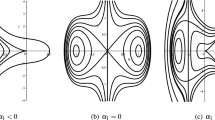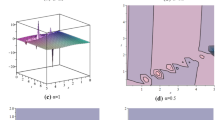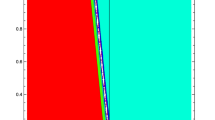Abstract
The focus of this article is to find some new exact solutions to the M-fractional paraxial nonlinear Schrödinger equation with Kerr media by employing the modified simple equation method and the auxiliary equation method. A set of novel travelling wave solutions are observed such as bright, dark, periodic and optical solitons. Moreover, the physical interpretation of nonlinear waves would also be demonstrated with the aid of scientific computing.
Similar content being viewed by others
Avoid common mistakes on your manuscript.
1 Introduction
The phenomena of NLSEs have attracted numerous researchers and scientists of recent era in the field optical fibre communication purposes and nonlinear optics such as, comprising spectroscopy, optical fibers, plasma physics and many more (Seadawy and Lu 2017; Bulut et al. 2018; Seadawy and Cheemaa 2019; Rizvi et al. 2020; Ali et al. 2020). Over the last few decades a renowned scientists have suggested several methods for solving nonlinear evolution equations (NLEEs), such as, the simple equation scheme (Abd El-Hameed 2020; Jawad et al. 2010; Khater et al. 2006; Seadawy and Cheemaa 2019), the exp-function scheme (Zhang 2008; Aslan 2013; Aslan and Marinakis 2011), the sine–cosine method (Wazwaz 2005, 2006), the homogenous balance method (He and Wu 2006; Mingliang 1996), the tanh–sech technique (Malfliet and Hereman 1996), the extended tanh–coth architectonics (Wazwaz 2008), the Kudryashov norm (Arnous and Mirzazadeh 2016), the soliton ansatz method (Fan and Hona 2002; Savescu et al. 2014), the semi-inverse variational principle (Seadawy et al. 2018; Eslami and Mirzazadeh 2016; Malfliet 1992), generalized mapping method Extended and modified direct algebraic method and Seadawy techniques (Seadawy and Cheemaa 2020; Dianchen et al. 2018a, b; Helal et al. 2014; Seadawy et al. 2019; Ozkan 2020). Such equations are extensively used to describe many important phenomena and dynamic processes in physics, chemistry, biology, plasma, optical fibers and other areas of engineering (Ozkan et al. 2020; Malfliet 1991; Arshad et al. 2017; Farah et al. 2020; Ali et al. 2018; Cheemaa et al. 2018, 2019; Iqbal et al. 2020). The NLEEs can be used to explain a wide range of physical phenomena of nature including vibration, heat, electrostatics, electrodynamics, fluid dynamics, elasticity, gravitation, and quantum mechanics (El-Shiekh and Al-Nowehy 2013; Akbulut and Kaplan 2018; Ilie et al. 2018a, b; Hosseini et al. 2020; Li et al. 2011, 2016, 2019).
The main goal of this paper is to search for some novel analytical solutions to the M-fractional paraxial NLSE in Kerr media by employing the modified simple equation MSE technique and the auxiliary equation (AE) method which reads (Atangana et al. 2015; Sirendaoreji and Jiong 2003).
where \(\mu _1\), \(\mu _2\) and \(\beta\), are the symbols of the dispersion, diffraction, and Kerr non-linearity. The D is a complex-valued function represents soliton profile (Sousa and de Oliveira 2018; Choi and Howell 2014).
This article designed as: in Sect. 2, the MSE technique and the AE scheme are employed to the given Eq. (1), while in Sect. 3 some 3D plots are utilized to demonstrate the structure of various solutions and in the last section some conclusions are illustrated.
2 Mathematical analysis
Consider the transformation
where
by using Eq. (2) in Eq. (1) and separating in real and imaginary parts, we obtain,
As \(U'\) is nonzero so
putting Eq. (6)into Eq. (4) we get a closed solution,
2.1 Applications of the MSEM
To construct the analytical solution to Eq. (7), consider its formal solution by applying the homogenous balance principle
where \(A_0\), \(A_1\) are constant and \(A_1\) not to b zero.
by substituting Eq. (8) with Eq. (9) and Eq. (10)into Eq. (7), we get a system of algebraic equations
by solving equation Eqs. (11) and (14), we found a set of following new exact solutions to the Eq. (1)
Case I:
by putting Eq. (15) in Eq. (13)
which gives
hence
therefore
Case II:
which gives
thus
Case III:
hence
Case IV:
therefore
2.2 Applications of the AEM
Consider the solution of Eq. (7) is of the form
where \(\psi (\xi )\) is satisfied the above ODE as:
Substituting Eqs. (31) and (32) into Eq. (7), we get the following system of algebraic equations
by solving the above system we get the following families of traveling wave solutions
Family I
Case I:
which gives
hence
Case II:
result will be:
hence
Case III:
third result will be in this form:
hence
Case IV:
fourth result will be:
hence
Case V:
hence
Case VI:
hence
Family II
when
Case I:
hence
Case II:
result will be:
hence
Case III:
result will be in this form:
hence
Case IV:
result will be:
hence
Case V:
result will be:
hence
Case VI:
result will be:
hence
3 Discussion and results
The following figures presents the graphical representation of solitons for various values of the parameters. Mathematica 11.0 is used to carry out simulations and to visualize the behavior of nonlinear waves. In each case Figs. 1, 2, 3, 4, 5, 6 and 7a–c demonstrate the structures for real, imaginary and absolute solutions respectively.
4 Concluding remarks
In this article, a set integration tools, namely the MSE technique and the AE methods are employed to find some novel exact traveling wave solutions to the M-Fractional paraxial NLSE with Kerr media. The proposed techniques are very powerful and may be effective to deal with many other nonlinear models arising in the recent era of the theory of optics. The geometrical structures of some selected solutions are also illustrated with the help of Mathematica 11.0.
References
Abd El-Hameed, A.M.: Polydatin-loaded chitosan nanoparticles ameliorates early diabetic nephropathy by attenuating oxidative stress and inflammatory responses in streptozotocin-induced diabetic rat. J. Diabetes Metab. Disord. 19, 1599–1607 (2020)
Akbulut, A., Kaplan, M.: Auxiliary equation method for time-fractional differential equations with conformable derivative. Comput. Math. Appl. 75(3), 876–882 (2018)
Ali, A., Seadawy, A.R., Dianchen, L.: Computational methods and traveling wave solutions for the fourth-Order nonlinear Ablowitz–Kaup–Newell–Segur water wave dynamical equation via two methods and its applications. Open Phys. 16, 219–226 (2018)
Ali, I., Seadawy, A.R., Rizvi, S.T.R., Younis, M., Ali, K.: Conserved quantities along with Painleve analysis and optical solitons for the nonlinear dynamics of Heisenberg ferromagnetic spin chains model. Int. J. Mod. Phys. B 34(30), 2050283 (2020)
Arnous, A.H., Mirzazadeh, M.: Application of the generalized Kudryashov method to the Eckhaus equation. Nonlinear Anal. Model. Control 21(5), 577–586 (2016)
Arshad, M., Seadawy, A., Lu, D.: Elliptic function and solitary wave solutions of the higher-order nonlinear Schrodinger dynamical equation with fourth-order dispersion and cubic-quintic nonlinearity and its stability. Eur. Phys. J. Plus 132, 371 (2017)
Aslan, İ: Some remarks on exp-function method and its applications—a supplement. Commun. Theor. Phys. 60(5), 521 (2013)
Aslan, I., Marinakis, V.: Some remarks on exp-function method and its applications. Commun. Theor. Phys. 56(3), 397 (2011)
Atangana, A., Baleanu, D., Alsaedi, A.: New properties of conformable derivative. Open Math. 13, 889–898 (2015)
Bulut, H., Sulaiman, T.A., Demirdag, B.: Dynamics of soliton solutions in the chiral nonlinear Schrödinger equations. Nonlinear Dyn. 91(3), 1985–1991 (2018)
Cheemaa, N., Seadawy, A.R., Chen, S.: More general families of exact solitary wave solutions of the nonlinear Schrodinger equation with their applications in nonlinear optics. Eur. Phys. J. Plus 133(547), 1–10 (2018)
Cheemaa, N., Seadawy, A.R., Chen, S.: Some new families of solitary wave solutions of generalized Schamel equation and their applications in plasma physics. Eur. Phys. J. Plus 134(117), 1–10 (2019)
Choi, J.S., Howell, J.C.: Paraxial ray optics cloaking. Opt. Express 22(24), 29465–29478 (2014)
Dianchen, L., Seadawy, A.R., Ali, A.: Applications of exact traveling wave solutions of modified Liouville and the symmetric regularized long wave equations via two new techniques. Results Phys. 9, 1403–1410 (2018a)
Dianchen, L., Seadawy, A.R., Ali, A.: Dispersive traveling wave solutions of the equal-width and modified equal-width equations via mathematical methods and its applications. Results Phys. 9, 313–320 (2018b)
El-Shiekh, R.M., Al-Nowehy, A.-G.: Integral methods to solve the variable coefficient nonlinear Schrödinger equation. Zeitschrift für Naturforschung 68, 255–260 (2013)
Eslami, M., Mirzazadeh, M.: Optical solitons with Biswas–Milovic equation for power law and dual-power law nonlinearities. Nonlinear Dyn. 83(1–2), 731–738 (2016)
Fan, E., Hona, Y.C.: Generalized tanh method extended to special types of nonlinear equations. Zeitschrift für Naturforschung A 57(8), 692–700 (2002)
Farah, N., Seadawy, A.R., Ahmad, S., Rizvi, S.T.R., Younis, M.: Interaction properties of soliton molecules and Painleve analysis for nano bioelectronics transmission model. Opt. Quantum Electron. 52(329), 1–15 (2020)
He, J.-H., Wu, X.-H.: Exp-function method for nonlinear wave equations. Chaos Solitons Fractals 30(3), 700–708 (2006)
Helal, M.A., Seadawy, A.R., Zekry, M.H.: Stability analysis of solitary wave solutions for the fourth-order nonlinear Boussinesq water wave equation. Appl. Math. Comput. 232, 1094–1103 (2014)
Hosseini, K., Mirzazadeh, M., Ilie, M., Gómez-Aguilar, J.F.: Biswas–Arshed equation with the beta time derivative: optical solitons and other solutions. Opt. Int. J. Light Electron. Opt. 217, 164801 (2020)
Ilie, M., Biazar, J., Ayati, Z.: Resonant solitons to the nonlinear Schrödinger equation with different forms of nonlinearities. Opt. Int. J. Light Electron Opt. 164, 201–209 (2018a)
Ilie, M., Biazar, J., Ayati, Z.: Analytical study of exact traveling wave solutions for time-fractional nonlinear Schrödinger equations. Opt. Quantum Electron. 50(12), 413 (2018b)
Iqbal, M., Seadawy, A.R., Khalil, O.H., Dianchen, L.: Propagation of long internal waves in density stratified ocean for the (\(2+1\))-dimensional nonlinear Nizhnik–Novikov–Vesselov dynamical equation. Results Phys. 16, 102838 (2020)
Jawad, A.J.M., Petković, M.D., Biswas, A.: Modified simple equation method for nonlinear evolution equations. Appl. Math. Comput. 217(2), 869–877 (2010)
Khater, A.H., Callebaut, D.K., Helal, M.A., Seadawy, A.R.: Variational method for the nonlinear dynamics of an elliptic magnetic stagnation line. Eur. Phys. J. D At. Mol. Opt. Plasma Phys. 39(2), 237–245 (2006)
Li, T., Han, Z., Sun, S., Zhao, Y.: Oscillation results for third order nonlinear delay dynamic equations on time scales. Bull. Malays. Math. Sci. Soc. (2) 34(3), 639–648 (2011)
Li, T., Zada, A., Faisal, S.: Hyers–Ulam stability of nth order linear differential equations. J. Nonlinear Sci. Appl. 9, 2070–2075 (2016)
Li, T., Pintus, N., Viglialoro, G.: Properties of solutions to porous medium problems with different sources and boundary conditions. Z. Angew. Math. Phys. 70(3), 1–18 (2019)
Malfliet, W.: Series solution of nonlinear coupled reaction–diffusion equations. J. Phys. A Math. Gen. 24(23), 5499 (1991)
Malfliet, W.: Solitary wave solutions of nonlinear wave equations. Am. J. Phys. 60(7), 650–654 (1992)
Malfliet, W., Hereman, W.: The tanh method: II. Perturbation technique for conservative systems. Phys. Scr. 54(6), 569 (1996)
Mingliang, W.: Solitary wave solutions for variant Boussinesq equations. Phys. Lett. A 6(212), 353 (1996)
Ozkan, Y.G., Yaşar, E., Seadawy, A.: On the multi-waves, interaction and Peregrine-like rational solutions of perturbed Radhakrishnan–Kundu–Lakshmanan equation. Phys. Scr. 95(8), 085205 (2020)
Ozkan, Y.G., Yasar, E., Seadawy, A.: A third-order nonlinear Schrodinger equation: the exact solutions, group-invariant solutions and conservation laws. J. Taibah Univ. Sci. 14(1), 585–597 (2020)
Rizvi, S.T.R., Seadawy, A.R., Ali, I., Bibi, I., Younis, M.: Chirp-free optical dromions for the presence of higher order spatio-temporal dispersions and absence of self-phase modulation in birefringent fibers. Mod. Phys. Lett. B 34(35), 2050399 (2020)
Savescu, M., Bhrawy, A.H., Hilal, E.M., Alshaery, A.A., Biswas, A.: Optical solitons in birefringent fibers with four-wave mixing for Kerr law nonlinearity. Rom. J. Phys. 59(5–6), 582–589 (2014)
Seadawy, A.R., Cheemaa, N.: Propagation of nonlinear complex waves for the coupled nonlinear Schrödinger equations in two core optical fibers. Phys. A Stat. Mech. Appl. 529(121330), 1–10 (2019)
Seadawy, A.R., Cheemaa, N.: Applications of extended modified auxiliary equation mapping method for high order dispersive extended nonlinear Schrodinger equation in nonlinear optics. Mod. Phys. Lett. B 33(18), 1950203 (2019)
Seadawy, A.R., Cheemaa, N.: Some new families of spiky solitary waves of one-dimensional higher-order K–dV equation with power law nonlinearity in plasma physics. Indian J. Phys. 94, 117–126 (2020)
Seadawy, A.R., Lu, D.: Bright and dark solitary wave soliton solutions for the generalized higher order nonlinear Schrödinger equation and its stability. Results Phys. 7, 43–48 (2017)
Seadawy, A., Kumar, D., Hosseini, K., Samadani, F.: The system of equations for the ion sound and Langmuir waves and its new exact solutions. Results Phys. 9, 1631–1634 (2018)
Seadawy, A.R., Iqbal, M., Lu, D.: Nonlinear wave solutions of the Kudryashov–Sinelshchikov dynamical equation in mixtures liquid–gas bubbles under the consideration of heat transfer and viscosity. J. Taibah Univ Sci. 13(1), 1060–1072 (2019)
Sirendaoreji, Jiong, S: Auxiliary equation method for solving nonlinear partial differential equations. Phys. Lett. A 309(5–6), 387–396 (2003)
Sousa, J.V.D.C., de Oliveira, E.C.: A new truncated \(M\)-fractional derivative type unifying some fractional derivative types with classical properties. Int. J. Anal. Appl. 16(1), 83–96 (2018)
Wazwaz, A.-M.: The tanh method and the sine–cosine method for solving the KP–MEW equation. Int. J. Comput. Math. 82(2), 235–246 (2005)
Wazwaz, A.-M.: The tanh and the sine–cosine methods for a reliable treatment of the modified equal width equation and its variants. Commun. Nonlinear Sci. Numer. Simul. 11(2), 148–160 (2006)
Wazwaz, A.-M.: New travelling wave solutions to the Boussinesq and the Klein–Gordon equations. Commun. Nonlinear Sci. Numer. Simul. 13(5), 889–901 (2008)
Zhang, S.: Application of Exp-function method to high-dimensional nonlinear evolution equation. Chaos Solitons Fractals 38(1), 270–276 (2008)
Acknowledgements
This Research was supported by Taif University Researchers Supporting Project No. (TURSP-2020/48), Taif University, Taif, Saudi Arabia.
Author information
Authors and Affiliations
Corresponding author
Additional information
Publisher's Note
Springer Nature remains neutral with regard to jurisdictional claims in published maps and institutional affiliations.
Rights and permissions
About this article
Cite this article
Tariq, K.U., Zainab, H., Seadawy, A.R. et al. On some novel optical wave solutions to the paraxial M-fractional nonlinear Schrödinger dynamical equation. Opt Quant Electron 53, 219 (2021). https://doi.org/10.1007/s11082-021-02855-6
Received:
Accepted:
Published:
DOI: https://doi.org/10.1007/s11082-021-02855-6











